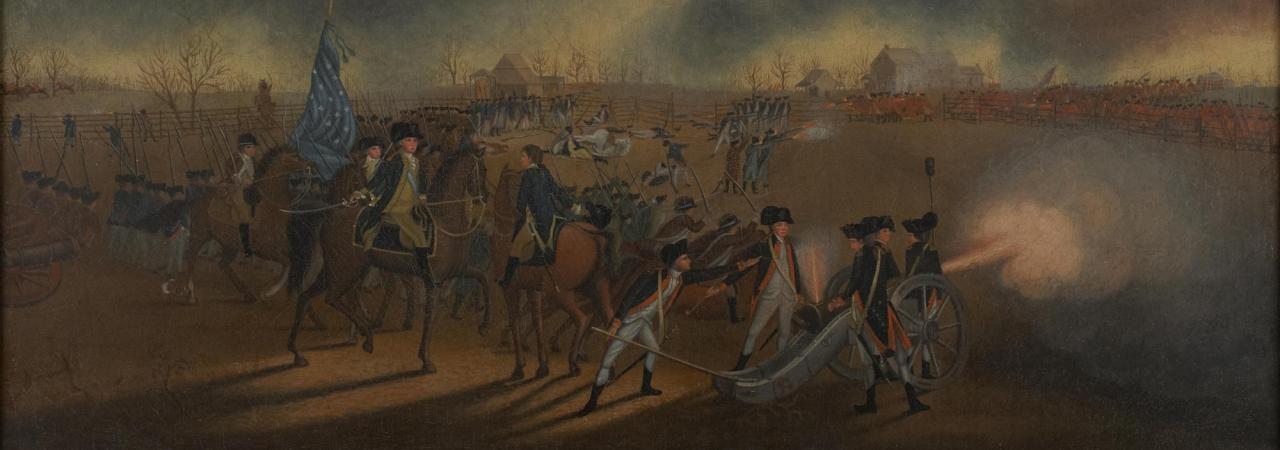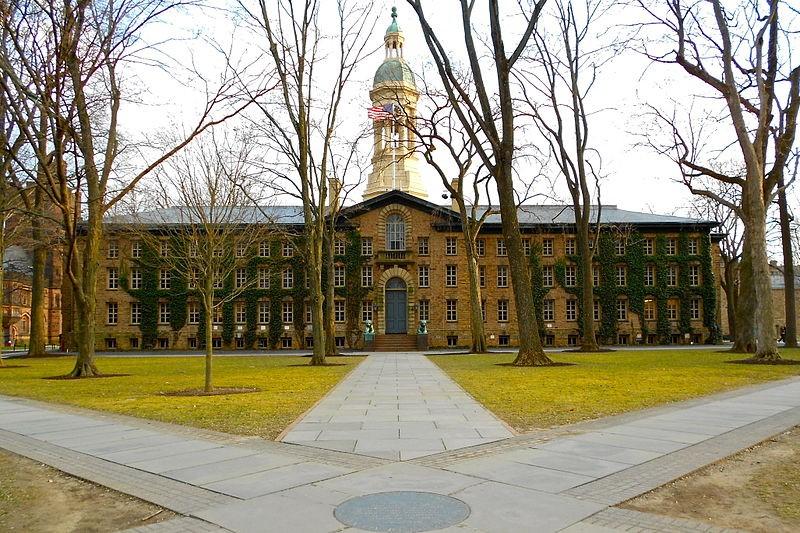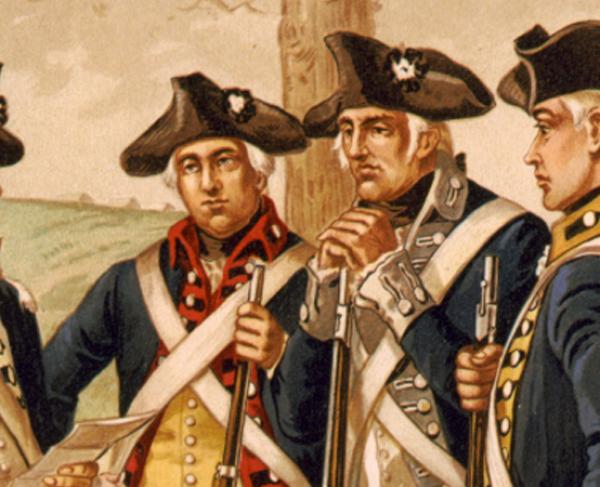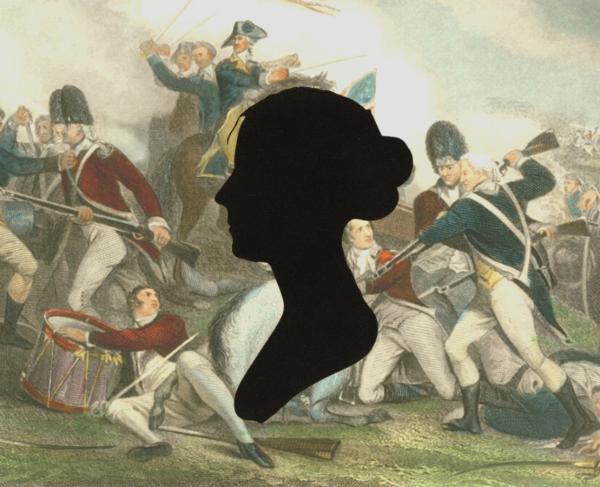
James Peale (1749-1831), The Battle of Princeton, ca. 1782,
When the American Revolution erupted into war, there were nine prominent institutions of higher learning in the American colonies. They educated many of the Founding Fathers and other American revolutionaries.
A notable absence from the rolls of the colonial colleges is George Washington, who never received a substantial formal education. Instead, Washington was a self-taught man who learned through prodigious reading (his library numbered over 1,200 volumes by the time he died) and through life experience.
Harvard was founded in 1636 in the colony of Massachusetts. It was the oldest and most prestigious of the colonial colleges. Among its alumni were John and Samuel Adams, John Hancock, and Joseph Warren, whose death at the Battle of Bunker Hill was immortalized in a painting by John Trumbull.
In May 1775, after the Battles of Lexington and Concord, Harvard gave its students an early summer vacation. The school moved to Concord, and held classes in an old grammar school, a courthouse, and a Congregationalist meetinghouse until June 1776. In Cambridge, over 1,600 soldiers were housed in Harvard’s five buildings, and George Washington briefly made his headquarters in the home of the college president. Soldiers tore off the lead roof of Harvard Hall to melt it down into bullets. In 1778, the Massachusetts House of Representatives awarded Harvard 417 pounds for the damages caused during its military occupation.
Yale College was founded in 1701 in the colony of Connecticut. Its longtime treasurer, Roger Sherman, was the only person who signed all four of the major documents of the American founding – the Articles of Association, the Declaration of Independence, the Articles of Confederation, and the United States Constitution. Its most famous revolutionary alumnus is Nathan Hale, who was executed by the British for spying in 1776.
The College of William & Mary was founded in 1693 in the colony of Virginia. Among its revolutionary alumni were future presidents Thomas Jefferson and James Monroe. When George Washington began his professional career as a surveyor at the age of 17, he received his surveyor’s certificate from William & Mary.
John Camm, the President of the College in 1775, believed that Virginia should remain loyal to the Crown. He continued to support Virginia’s colonial governor, Lord Dunmore, even after Lexington and Concord and the Gunpowder Incident. Camm refused to remove the King’s name from official documents, and he also refused to take an oath of loyalty to the new Commonwealth of Virginia. In 1777, he was ousted as college president and replaced by a pro-Patriot member of the faculty. A company of Virginia militia was called the “William and Mary Company,” because it was composed almost entirely of students and faculty from the College. It served alongside the Continental Army at the Siege of Yorktown.
The College of New Jersey (now Princeton University) was founded in 1746 in the colony of New Jersey. Among its revolutionary alumni were James Madison and Aaron Burr.
Princeton was the only one of the colonial colleges where the student body engaged in large-scale acts of rebellion, including breaking into the college storeroom and burning all the steward’s tea. Princeton campus was also the scene of the final moments of the Battle of Princeton on January 3, 1777. The battle began less than 2 miles south of the campus and ended when Alexander Hamilton ordered cannons to fire on British troops occupying Nassau Hall, forcing them to surrender.

King’s College (now Columbia University) was founded in 1754 in the colony of New York. Among its revolutionary alumni were John Jay, Robert Livingston, Gouverneur Morris, and Alexander Hamilton.
Like William & Mary, the leadership of King’s College on the eve of the Revolution made every effort to keep the school and its students loyal to the British government. In May 1775, a mob stormed the home of Myles Cooper, the President of the College. Cooper fled to the safety of a British warship and then sailed back to England, as did many of the Loyalist faculty and leadership. Many of the college buildings were destroyed by the same fire that destroyed much of New York City after the British took control of the city in 1776. After the Revolutionary War, the Board of Governors changed the name of the school to Columbia College to erase its royal connection.
The College of Philadelphia (now University of Pennsylvania) was founded in 1755 in the colony of Pennsylvania. General Anthony Wayne studied at the College for a time, but did not earn a degree. General Thomas Mifflin and Robert Morris, the “financier of the Revolution,” were both members of the board of trustees at one point.
The College was founded in part by Benjamin Franklin, but Franklin had little to do with the college after its board of trustees chose the Reverend Richard Peters, rather than Franklin, to be the President of the College in 1756. Peters wrote to the Continental Congress in February 1776 to urge reconciliation, and privately called Thomas Paine’s Common Sense “Common Nonsense.” In 1779, the Pennsylvania Assembly revoked the college’s charter. In its place, they created the University of the State of Pennsylvania, whose board of trustees pledged to “forever renounce and refuse all allegiance, subjection and obedience to the King and Crown of Great Britain.” The College was restored in 1789 and merged with the University of the State of Pennsylvania in 1791 to become the University of Pennsylvania.
The College of Rhode Island (now Brown University) was founded in 1764 in the colony of Rhode Island. One of its founders, John Brown, led a group of colonists that burned the British customs schooner HMS Gaspee near Newport in 1772. The first chancellor of the college, Stephen Hopkins, was a signer of the Declaration of Independence. James Varnum, a member of Brown’s first graduating class, founded and led the 1st Rhode Island Regiment, one of the first black units in the American military.
The college was closed from December 1776 to September 1782, because of the war. The college was supposed to re-open in 1780, but it was commandeered as a hospital and barracks for French soldiers under the Comte de Rochambeau. These troops would march south to Yorktown for the climactic battle of the war. After the war, the College sent a bill to the United States Congress for the damages its buildings had endured. The College asked for over $7,000 but received just under $3,000.
Queen’s College (now Rutgers University) was founded in 1766 in the colony of New Jersey. It held its first commencement in 1774, less than a year before the outbreak of the Revolutionary War. The sole member of the graduating class of 1776, Simeon De Witt, served as the surveyor general of the Continental Army and created topographic maps that helped Washington and the Continental Army plan the Siege of Yorktown.
Dartmouth College was founded in 1769 in the colony of New Hampshire. It produced few Patriots, but it is notable for being the old American college to produce a graduating class every year since 1771, even during the Revolutionary War, the War of 1812, and other conflicts.
Related Battles
75
270




